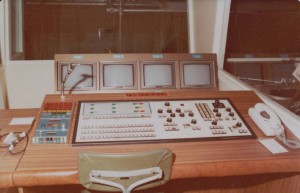The first production switcher I encountered at RTVF was a Richmond-Hill switcher that was installed in Control Room “A”. The control panel had 16 video sources plus M/E re-entry. However, back in Tech Center, the frame only had circuit boards enough to support 4 video inputs. I could only assume that this was a reflection of the budget limitations at the time of the switcher’s purchase. Here is a photo of a similar switcher. I was able to find only one photo on the web, and it is from a page of history from a TV station in Australia.
An unusual feature of this switcher involved setting up for a key. Several switchers had “push-to-preview” key clip knobs, but this one switched the M/E monitor to “key” when you touched the key clip knob. Very cool! The unit had been modified with a toggle switch to turn “off” the color burst on the black/background generator. 3/4 inch machines of the day would activate their internal color processing circuitry based upon whether the video input had “burst” in the sync interval. Fading a monochrome camera to switcher black (with the burst turned on) would cause an obvious glitch upon playback. This is demonstrated in the RTVF 440 clip when switching to the black and white film chain from the color studio cameras.
As we got VTRs up and running and added cameras to the studio, we needed to add input capability to the switcher. Each source required a video input/proc card, and two video matrix cards. We involved the Physics Department support team in laying out printed circuit artwork, and manufactured our own boards. We taught RTVF interns to properly mount all the on-board components to the pre-drilled boards. I was rather particular, and wanted all the resistor color code bands to point the same way on the boards. We taught the soldering skills needed to ensure quality connections. That’s the extent of the engineering involvement in making the boards….the interns did all the assembly, and when I found the very few that did not work, the interns went over their work and corrected the problems. Bob McCleary found the address of my component supplier to be amusing, for some reason. I used Digi-Key, and they were located in Thief River Falls, MN.
This was an early indicator of how things would be. The RTVF equipment budget was virtually nil at that time. If engineering needed something, we had to either build it, or find it at the Jessup Surplus Depot.
UPDATE
A telephone conversation with Gene Weiss revealed the source of the Richmond Hill switcher. The switcher was part of a horse-trade between Gene and a local production house. Gene did not recall the name of the facility, so we will never know why it was purchased with only 4 inputs. But the fact that it was not originally purchased by RTVF clears up one of the questions on my list.
